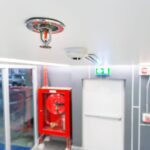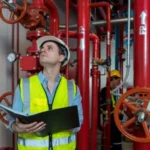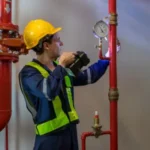Fire safety is a must when it comes to guarding commercial and industrial buildings. Different levels of fire risk are found at factories, warehouses, data storage centers, and office buildings due to their operations, materials involved, and equipment being used. Picking a fire suppression system isn’t just about being compliant; it is about protecting people, reducing damage, and protecting investment-grade property.
In this article, we will review the top types of fire suppression systems for commercial and industrial buildings, the advantages provided by fire suppression systems, and the importance of making the right fire protection investment for long-term safety.
Fire Safety Plan Including Fire Suppression with Fire Protection
A fire safety plan coordinates your suppression systems with the alarms, extinguishers, and evacuation plan. Here is how it all fits together:
- Detection: Early warning sensors/smoke detectors will alert you to a fire hazard.
- Suppression: Manual or automatic suppression systems will activate to either control the fire or extinguish it.
- Notification: A fire alarm will go off, alerting building occupants alerting them to exit the building safely.
- Aftercare (or what happens next): Trained staff and your local first responders will take over to manage the aftermath.
In conclusion, these layers of protection will provide a defensible barrier from fire hazards that impact any commercial or industrial property.
Fire Suppression Systems Explained
A fire suppression system can automatically identify, manage, or extinguish fires, frequently before the fire spreads. These suppression systems are not like traditional sprinkler system that utilizes water alone. The new technology suppression systems use gas, foam, or chemical agents based on the appropriate agent for the identified fire hazard.
In industrial or commercial settings, especially in instances where water would cause harm to fragile machinery or equipment, alternative suppression systems can provide a safer and effective option.
1. Water-Based Fire Suppression Systems
Water-based systems are the most frequently used option in large facilities. The main performing agent in this suppression system is the fire sprinkler system. Immediately after detecting the heat, the sprinkler heads will let water out to suppress the flames and prevent the fire from spreading.
There are three types of sprinkler systems:
- Wet Pipe Systems: These systems are filled with water at all times and offer immediate delivery once activated.
- Dry Pipe Systems: These systems are filled with pressurized air instead of water until needed. They are considered a good option for colder environments because the pipes can freeze and require air to be added.
- Pre-Action Systems: These systems require one separate event to detect the fire before water is released. This is typically used in data centers or archive-like spaces.
All systems are of lower cost and very reliable, and will provide continuous protection with little maintenance needs.
2. Clean Agent Fire Suppression Systems
These kinds of fire suppression systems are created to protect places that contain sensitive electrical and electronic machines and equipment. For instance, technical laboratories, control centers, and server rooms. Clean agent systems use gaseous agents, such as FM-200 or Novec 1230, to put out a fire, leaving no residue behind and not producing any harm to the electronic systems.
When the gaseous agent is delivered, it acts quickly enough to terminate the underlying chemical reaction, gas—fire. These systems are fast and clean from a fire suppression perspective, and also have the effect of minimizing downtime (and cleanup) due to the brand of non-residue leaves behind.
Key features:
- Safe for people and electronics
- No water damage
- Rapid suppression (in seconds)
Clean agent systems are a great option for organizations that are focused on safety and continuity of operations.
3. CO₂ Fire Suppression Systems
CO₂ systems are among the oldest and most effective suppression mechanisms, particularly in industrial locations. It operates by displacing oxygen within the atmosphere, starving the fire and stopping combustion.
They are typically utilized around flammable liquids, paint booths, and heavy machinery – conditions where water or foam would have no effect.
CO₂ systems can be dangerous in enclosed spaces, especially if people are present. Because of this, they are often only installed in unoccupied areas or with alarms and delay features as precautions.
4. Foam-Based Fire Suppression Systems
Foam suppression systems are especially useful in industries that deal with flammable liquids, like fuel storage facilities, chemical plants, and refineries. The foam creates a blanket over the burning surface to eliminate oxygen and absorbs heat in the area, preventing re-ignition. They provide excellent performance against Class B fires (flammable liquids and gases) and can also be used together with water systems as combined hybrid protection.
Advantages include:
- Rapid knockdown of liquid fires
- Prevention of vapor release
- Reduced risk of re-flash
5. Dry Chemical Fire Suppression Systems
Dry chemical systems use powders to interrupt the chemical reactions of fire. They are commonly installed in paint spray booths, automotive facilities, and industrial plants.
These systems are fast-acting and effective for various fire classes, including electrical, liquid, and solid combustibles. However, cleanup can be messy, which makes them less ideal for sensitive areas.
Their affordability and versatility make them one of the most practical fire suppression solutions for industrial sites.
6. Hybrid Fire Suppression Systems
Hybrid systems integrate the advantages of inert gas and water mist to provide sophisticated fire protection. They use water droplets (which are very small) with gas to cool the flame and displace oxygen concurrently. Hybrid systems perform very well in data centers, power plants, and logistics warehouses when precise fire protection is critical due to sensitive equipment or high-value assets.
Choosing the Right Fire Suppression System
Selecting the appropriate suppression system depends on several factors:
- Type of materials handled (flammable, electrical, or corrosive)
- Room occupancy
- Equipment sensitivity
- Potential downtime costs
- Regulatory requirements
It’s best to consult a certified fire protection services provider who can assess your facility’s unique risks and design a custom system that aligns with safety regulations and business needs.
Conclusion
Fire suppression systems or fire safety equipment act as quiet guardians in the safety of industrial and commercial operations. Whether it be water-based sprinkler systems, clean agents, or foam systems, each system has its advantages working in different environments. The trick is to understand something that works for your operation and to have the fire protection and inspection program to service your system adequately.
When you are operating a factory, warehouse, or corporate office, reliable fire suppression technology is important not only for compliance; it is potentially life-safety, business continuity, and peace of mind.
FAQs
1. In what ways do fire sprinkler systems differ from fire suppression systems?
Fire sprinkler systems differ from fire suppression systems in one key aspect. Fire sprinkler systems mainly use water, whereas fire suppression systems use other agents (gas, foam, chemicals, etc.) to combat different fire hazards, especially where sensitive applications or industrial installations are concerned.
2. How often should fire extinguishers be inspected?
Fire extinguishers must be inspected each month to verify there are no signs of visible damage and ensure the pressure readings are still at a safe level. Fire extinguishers must also be professionally inspected annually to ensure it is compliant and operational.
3. Why is it important to test fire alarms in commercial buildings?
It is important to test fire alarms to verify that the smoke detectors, alarms, and panels are operational. Regular testing helps to ensure each fire alarm is working correctly so there will be an alert in case of emergencies and to comply with fire safety regulations/laws.







